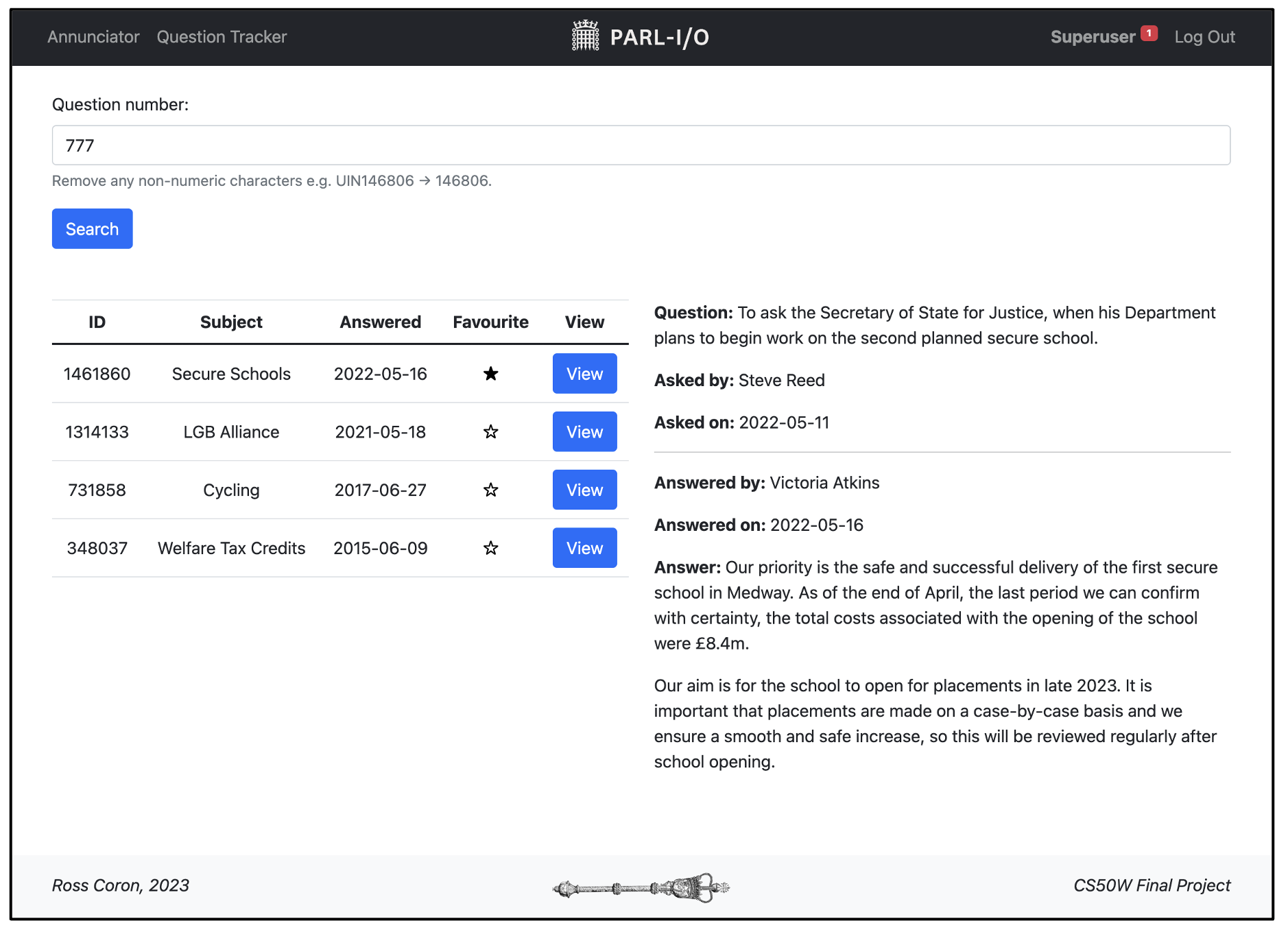Hello World!
Welcome to Parl-I/O ('Parlio'), designed and implemented as my final project for Harvard's CS50 Web Programming with Python and JavaScript course. Parl-I/O is a web application written primarily in Python (Django) and JavaScript.
Making use of the UK Parliament's public API, Parl-I/O provides the real-time sitting status of both Houses of Parliament (House of Commons and House of Lords); allows users to search and view written Parliamentary questions (PQs); bookmark questions for later viewing; and set up alert notifications for unanswered questions. Parl-I/O additionally provides basic user-handling, allowing visitors to create an account for the application as well as log in and out.
Watch a video walkthrough of Parl-I/O HERE!
# Create new migrations
python3 manage.py makemigration
# Migrate
python3 manage.py migrate
# Start development server
python3 manage.py runserver
# In browser, navigate to generated URL (typically local host http://127.0.0.1:8000/)
To navigate Parl-I/O, use the app's NavBar. All pages (except the app's index page) requires the user to have an account with the application and be signed in (go to Register / Log In). Parl-I/O's default Index page displays the live sitting status of Parliament; Questions allows users to search, view, bookmark, and set up Parliamentary Question alerts; User displays a user's bookmarked questions and notifications.
Parl-I/O follows a typical Django file structure. Python code corresponding to each of the app's 'views' (both visible and API) is stored in the file views.py. The site's various URL patterns can be found in urls.py. The app's in-built database is built on three tables (User, Question, and Notification) defined in the file models.py, with the database saved as db.sqlite3.
The website consists of six HTML pages, most of which extend from a layout file (layout.html) using Django's templating language. These files are stored in the templates directory. index.html (the app's default route), displays Parliament's sitting status; question.html allows users to search, view, bookmark, and set up Parliamentary Question alerts; user.html displays a user's bookmarked questions and notifications.
The static folder contains two sub-folders: media, which stores the app's images, icons, and sound files, and js which stores the app's JavaScript code. Most of the JavaScript files correspond to a single webpage, but background.js (which continually checks if a user has any notifications) is shared between multiple pages. Parl-I/O's custom CSS and animations are stored in style.css.
Outside of these core files, the app's dependencies can be found in requirements.txt and environment variables in .env.
Parl-I/O is a web application written in Python, JavaScript, HTML, and CSS. The application contains a SQLite database, with data managed through Python objects ('models'). Parl-I/O utilises the Django web framework and Bootstrap CSS framework.
Parl-I/O make use of the UK Parliament's Developer Hub, particularly the 'Written Questions' and 'Parliament Now' APIs. The application has 7 'visible' URL routes (i.e. routes which render an HTML page) and 6 'API' routes. Querying Parliament's APIs and / or updating the app's underlying database, these routes:
- Check if a selected question is on a user's watchlist
- Check if an unanswered question has now been answered
- Bookmark / unbookmark a question
- Add / remove a question from a user's watchlist
- Checks the current sitting status of Parliament
- Dismisses a user's notification
While Python does most of Parl-I/O's heavy lifting (rendering HTML pages, updating the app's database, processing data, etc.), JavaScript is used to retrieve data (typically in the form of asynchronous fetch functions, passing over to backend API functions (described above) for processing) and update HTML pages as required.
Built from scratch (i.e. an empty Django template, not the programming language!) Parl-I/O utilises many of the tools and techniques covered in CS50W. By providing bookmarking and notification functionality by combining a public API and inbuilt database, Parl-I/O goes beyond a simple API querier, significantly building on Parliament's own website.
Created to address challenges in my professional role in Parliament, and incorporating a number of techniques not covered in CS50W, Parl-I/O is distinct from, and significantly larger and more complex than the course's previous PSETs.
In respect to CS50W's other grading requirements, Parl-I/O is mobile responsive, utilises Django (with three associated models), and JavaScript as described above.
- Elizabeth Tower (Big Ben) favicon - LINK
- House of Commons / Lords icons - LINK
- Parliament's Developer Hub - LINK
- CS50W - LINK
Hi, I'm Ross Coron! I'm a driven, creative, and experienced policy professional. I have a proven track record of furthering the Government's agenda as a Civil Servant and in scrutinising its work as a Policy Analyst in the House of Lords. I previously worked at Blood Cancer UK (policy / public affairs) and the University of St Andrews, Institut Pasteur, and Imperial College London (PhD and postdoctoral research). I'm interested in all-things policy, programming, pipetting.
Let's connect!
